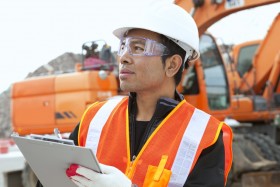4 Types of Workplace Hazards

There are a lot of ways to get hurt on the job and no workplace is ever completely and totally free of hazards. Even if you work in a seemingly safe environment like an office, it’s still entirely possible to encounter at least one type of hazard at work. Naturally, the exact types of hazards you might encounter on the job will vary depending on where you work and what kind of work you do, but generally speaking, these are some of the most common types of workplace hazards to keep an eye out for.
4 Types of Workplace Hazards
1. Physical Hazards
Physical hazards are the most common type of workplace hazards. A physical hazard is something about the workplace itself which can pose a danger to workers, such as things that can be tripped over, working at a height, frayed or damaged electrical cords, or machinery with exposed moving parts. But while those types of things are easy to spot, physical hazards aren’t always visible. They can also include things like consistently high levels of noise, mold in the workplace, vibrations, exposure to radiation, or poor ventilation and air quality.
2. Biological Hazards
If you work in a hospital, doctor’s office, nursing home, veterinary/zoological office, or with certain types of plants, you’ll want to be particularly mindful of biological hazards. Since these types of occupations can involve dealing with bodily fluids or people who are ill, you’re at risk for being exposed to things like viruses, bacteria, and bloodborne pathogens. If you work with plants, things like dangerous types of fungus or mold could be a workplace hazard.
3. Ergonomic Hazards
Ergonomic hazards are an extremely common type of workplace hazard. They can exist in many different types of work environments, ranging from offices to factory assembly lines. An ergonomic hazard is something which can put strain on a person’s musculoskeletal system, such as sitting at a chair or workstation that isn’t properly adjusted, making repetitive movements throughout the day, or making strenuous/awkward movements throughout the day.
While some types of workplace hazards are fairly easy to spot during a routine inspection, ergonomic hazards often go overlooked because they’re not very visible. For example, it’s much easier to see something that could be tripped over than it is to tell whether or not someone’s desk or chair is adjusted correctly. Another problem is that ergonomic hazards might not initially seem like real hazards. When a person first feels the effects of an ergonomic hazard, it often seems pretty superficial, maybe just that their muscles are just a little bit sore. But over time, ergonomic hazards can take a more significant toll on a person’s body.
4. Chemical Hazards
Many types of occupations involve working with chemicals, whether they’re ordinary cleaning supplies or powerful pesticides and solvents. When used correctly, many of these chemicals can be safe to work with. But if chemicals aren’t labeled clearly, stored properly, or used with proper precautions, workers can get hurt. Some types of chemicals may be highly flammable while others can give off toxic vapors or cause skin irritation.
Get Help if You’re Injured by Hazards at Work
If you’ve been injured as a result of any of these workplace hazards, contact an unsafe workplace lawyer as soon as possible. A lawyer will be able to answer any questions you might have, such as if your injuries are covered by worker’s comp and what legal options are available to you.
The Law Offices of Goodwin & Scieszka have personal injury attorneys that are well-versed in other injuries and accidents outside of the workplace, like slip and falls. Contact us for any legal help to see how you can get compensated for your accident.






